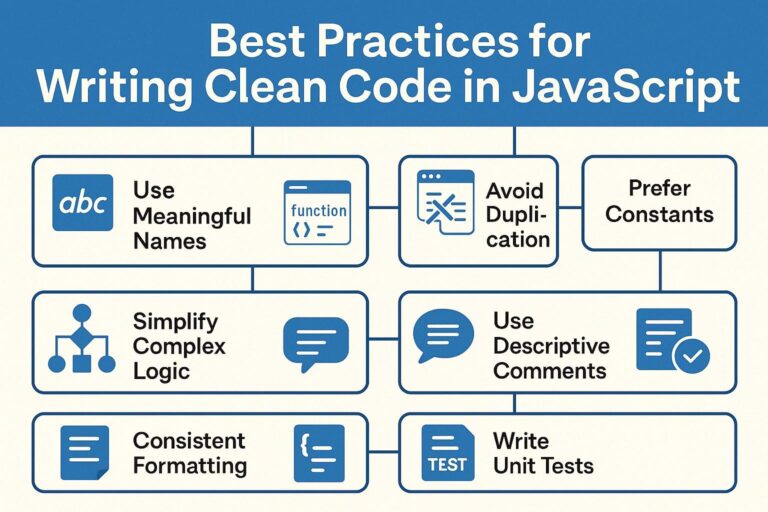
Choosing the right JavaScript framework or library is a foundational decision when building modern web applications. React, Vue, and Angular are the most popular front-end tools used by developers today. Each brings a different philosophy, structure, and level of complexity to web development, and the choice between them can greatly influence your project’s architecture, scalability, and maintainability.
This guide offers a detailed comparison of React, Vue, and Angular based on architecture, performance, learning curve, ecosystem, scalability, tooling, and real-world applicability, helping you make an informed decision based on your development needs and goals.
Overview of the Frameworks
React (Developed by Meta/Facebook)
- Type: UI library
- Initial Release: 2013
- Primary Language: JavaScript with JSX
- Architecture: Component-based, declarative, unopinionated
React is a library focused on building reusable UI components. Its core philosophy centers on the idea of a virtual DOM, one-way data flow, and the componentization of UI logic. React is highly flexible and allows developers to structure their applications with custom toolsets.
Vue (Created by Evan You)
- Type: Progressive JavaScript framework
- Initial Release: 2014
- Primary Language: JavaScript (supports TypeScript)
- Architecture: MVVM (Model-View-ViewModel)
Vue offers a gentle learning curve with a declarative syntax and reactive data binding. It is designed to be incrementally adoptable, which means you can use it for part of your application or build entire front-end solutions.
Angular (Developed by Google)
- Type: Full-featured web application framework
- Initial Release: 2016 (Angular 2+)
- Primary Language: TypeScript
- Architecture: Component-based, dependency injection, opinionated
Angular is a comprehensive framework with built-in support for routing, forms, HTTP client, and testing. It follows strict design patterns and offers robust tooling and structure, making it ideal for large-scale enterprise applications.
Comparison Table: React vs Vue vs Angular
| Feature | React | Vue | Angular |
|---|---|---|---|
| Type | Library | Progressive framework | Full-featured framework |
| Language | JavaScript + JSX | JavaScript / TypeScript | TypeScript |
| Architecture | Unopinionated | Progressive + Optional modules | Opinionated, all-inclusive |
| Initial Release | 2013 | 2014 | 2016 (Angular 2+) |
| Learning Curve | Moderate | Easy to Moderate | Steep |
| Core Size | ~45 KB | ~30 KB | ~500 KB |
| DOM Manipulation | Virtual DOM | Virtual DOM | Real DOM + Change Detection |
| Data Binding | One-way | Two-way (with v-model) | Two-way |
| Component Model | Function components + Hooks | Options & Composition API | Class-based with decorators |
| Routing | React Router | Vue Router | Angular Router |
| State Management | Redux, Recoil, Zustand, Jotai | Vuex, Pinia | RxJS Services, NgRx |
| CLI Tool | Create React App, Vite | Vue CLI, Vite | Angular CLI |
| Ecosystem | Highly flexible, choose tools | Integrated ecosystem | Full-stack tooling built-in |
| Corporate Backing | Meta (Facebook) | Independent (community driven) | |
| Mobile Development | React Native | Vue Native, NativeScript | Ionic with Angular |
Performance and Rendering Efficiency
All three frameworks are highly performant, but the underlying rendering mechanisms differ.
- React uses a virtual DOM and reconciliation algorithm to efficiently update the UI by minimizing DOM mutations. This makes it fast and suitable for dynamic applications.
- Vue also utilizes a virtual DOM but combines it with a highly efficient reactivity system that tracks dependencies and updates only the necessary components.
- Angular employs a real DOM with a zone-based change detection system. Although the initial load may be heavier, Angular is optimized for scalable enterprise-level apps and handles complex UI rendering effectively when configured properly.
Learning Curve and Developer Experience
React
- Moderate to advanced learning curve due to JSX, state management (e.g., Redux), and the necessity of learning supporting libraries.
- The freedom to choose tools can be overwhelming for newcomers.
- Well-documented and supported by a large community.
Vue
- Considered the most beginner-friendly framework among the three.
- Simple template syntax similar to HTML makes onboarding easier.
- Clear documentation and smaller API surface area simplify learning.
Angular
- Steepest learning curve due to the use of TypeScript, decorators, modules, services, RxJS, and CLI tooling.
- Offers strong type safety and architectural guidance, but can be overwhelming for small teams or solo developers.
- Ideal for developers familiar with OOP and enterprise software design patterns.
Flexibility and Modularity
- React offers maximum flexibility. Developers choose how to handle routing, state, and side effects. While this allows customization, it also places responsibility on the developer to choose and integrate tools.
- Vue provides a balance between flexibility and structure. Core modules such as Vue Router and Pinia/Vuex are available but not mandatory.
- Angular is highly opinionated. It offers a comprehensive solution with all necessary tools built-in. This provides consistency but limits flexibility when switching libraries or architectures.
Ecosystem, Tooling, and Community Support
- React has one of the largest ecosystems, including powerful tools like Next.js for SSR, React Native for mobile, and tools like Vite, Parcel, and Webpack. The job market is extensive, and it is widely adopted in the industry.
- Vue has a growing ecosystem, including Nuxt.js (for SSR), Vue CLI, Vite, and integrations with tools like Vuetify, Quasar, and Element UI. While its job market is smaller, it has a strong community and adoption among startups and Asian markets.
- Angular has a mature ecosystem with a robust CLI, Angular Material, built-in testing libraries, and integration with Ionic for mobile development. It’s widely used in enterprise and government projects.
Real-World Use Cases
React
- Ideal for projects requiring high flexibility, reusability, and performance.
- Popular in startups, SaaS applications, e-commerce platforms, and enterprise dashboards.
- Used by Facebook, Instagram, Netflix, Airbnb, and Uber.
Vue
- Excellent for small-to-medium applications, MVPs, and internal tools.
- Great choice for developers prioritizing ease of use and rapid prototyping.
- Used by Alibaba, Xiaomi, and GitLab.
Angular
- Preferred for enterprise-scale applications, administrative dashboards, and apps with complex workflows.
- Offers structure, testability, and scalability for large development teams.
- Used by Google, Microsoft, Deutsche Bank, and many government institutions.
Pros and Cons Summary
React
Pros
- High flexibility with custom setups
- Huge developer community
- Fast rendering and scalable architecture
- Rich ecosystem (React Native, Next.js)
Cons
- Not a full framework—requires combining third-party tools
- JSX has a learning curve for beginners
- Boilerplate grows with state management tools
Vue
Pros
- Easy to learn and integrate
- Lightweight and fast
- Clear documentation and smaller API
- Good default libraries (Vue Router, Pinia)
Cons
- Smaller corporate adoption
- Less mature ecosystem for enterprise apps
- Rapid changes in core API (Composition API shift)
Angular
Pros
- Complete framework with official solutions for most needs
- Strong typing and modular structure
- Enterprise-level architecture support
- Built-in support for forms, HTTP, and testing
Cons
- Steep learning curve
- Verbose code and complex setup
- Larger bundle size compared to React and Vue
Choosing the Right Framework for Your Project
| Use Case or Preference | Recommended Framework |
|---|---|
| Learning web development for the first time | Vue |
| Building a scalable enterprise application | Angular |
| Developing a dynamic, component-driven UI | React |
| Working with an existing team using TypeScript | Angular or React |
| Creating an MVP with fast turnaround | Vue or React |
| Prioritizing long-term maintainability | Angular |
| Building a mobile app with shared codebase | React (React Native) |
| Needing full control over architecture | React |
Final Thoughts
React, Vue, and Angular each offer unique strengths that cater to different developer needs and project requirements. There is no definitive “best” framework—only the best fit for a specific context.
- Choose React if you prioritize flexibility, performance, and a strong developer ecosystem.
- Choose Vue if you want simplicity, rapid development, and ease of integration.
- Choose Angular if your project demands structure, scalability, and a comprehensive toolset.
Regardless of the framework you choose, focus on building strong fundamentals in JavaScript, understanding component-based architecture, and learning modern development practices. Mastering one framework thoroughly will make it easier to transition to others as needed.

I’m Shreyash Mhashilkar, an IT professional who loves building user-friendly, scalable digital solutions. Outside of coding, I enjoy researching new places, learning about different cultures, and exploring how technology shapes the way we live and travel. I share my experiences and discoveries to help others explore new places, cultures, and ideas with curiosity and enthusiasm.






